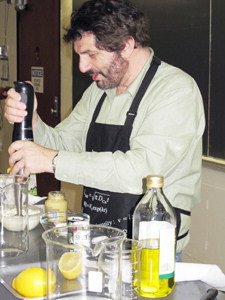‘Physics and Cooking’ public lecture available online

If you ever wanted to know why the elasticity of steak matters or why some chefs use liquid nitrogen (at about -320 degrees F) to freeze ingredients, now you will have your questions answered.
The School of Physics and Astronomy recently hosted a “Physics and Cooking” public lecture by Harvard University Physics Professor David Weitz. More than 500 people attended the lecture. You can view the lecture online and download the recipes used in the lecture.
The lecture by Harvard University Professor David Weitz is inspired by understanding the science of pioneering approaches to preparation and presentation of foods at several famous restaurants. His talk presents some examples of physics and science of cooking and includes demonstrations. The lecture explores the science of several innovative techniques in cooking, including foams and use of gelation, as well as more common processes.
The examples are based on an introductory science course, entitled "Science and Cooking: From Haute Cuisine to the Science of Soft Matter," offered at Harvard University by Weitz and a team of top international chefs, including Ferran Adrià, founder of the Alícia Foundation. The course explores a new way of motivating interest in science and teaching it to non-scientists. The theme of the course is the connections between cooking, soft matter physics, materials science, and organic chemistry.
Weitz received his Ph.D. from Harvard. He worked at Exxon Research and Engineering as a research physicist for nearly 18 years, and then became a physics professor at the University of Pennsylvania. He is currently a professor of physics and applied physics and the director of Harvard's Materials Research Science and Engineering Center. Weitz is a member of the National Academy of Sciences and the American Academy of Arts and Sciences.
